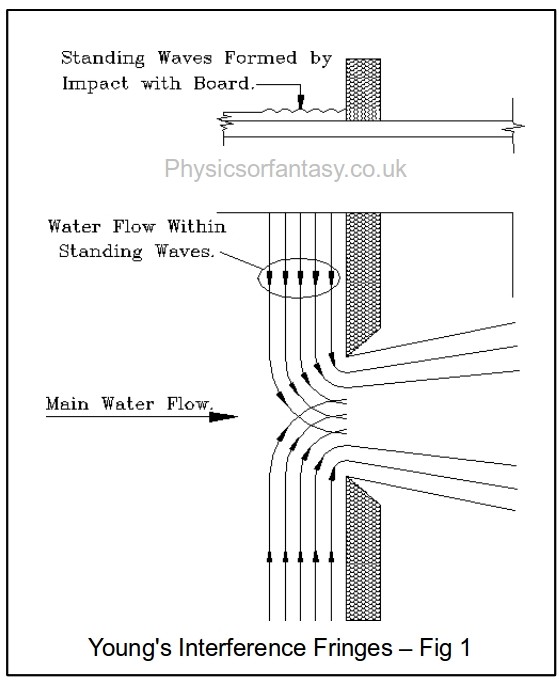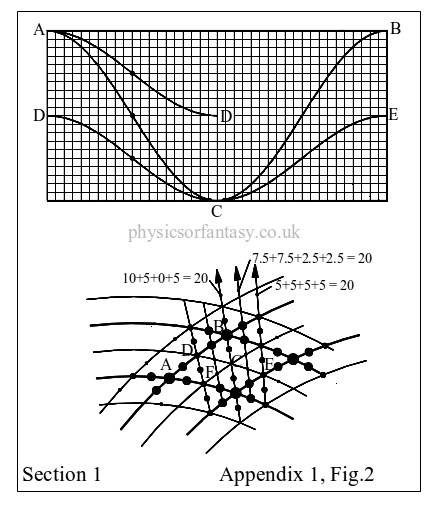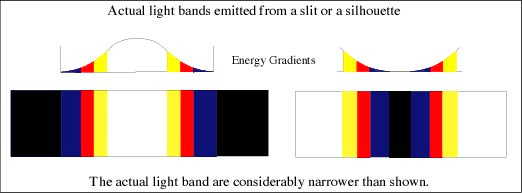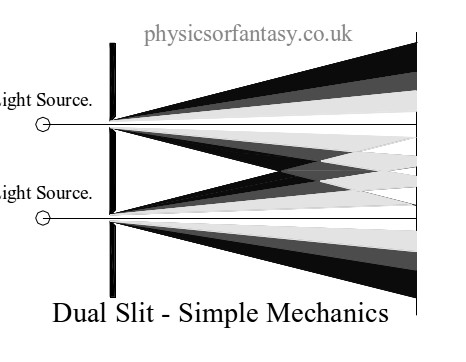-
What is a Photon?
Posted on April 15th, 2016 No commentsConsider the following two statements.
“Photons behave in some ways like particles, little bits of stuff, and in other ways like waves. It’s not just visible sunlight that is made of photons, but a lot of other kinds of waves like radio waves, television broadcasts, x-rays, and the ultraviolet (UVA and UVB) rays that give you sunburns. The difference between light and these other kinds of waves depends on the size of the wave – the wavelength. Very short waves are x-rays and ultraviolet rays, that cause sunburn. Visible light like sunlight is made of medium-length waves. Radio and television waves are very long waves. But all of these rays are made of photons. “ (http://quatr.us/physics/light/photon.htm)
“Wave-Particle Duality in Brief
As mentioned above, light has properties of both a wave and a particle. This was an astounding discovery and is certainly outside the realm of how we normally perceive things. Billiard balls act as particles, while oceans act as waves. Photons act as both a wave and a particle all the time (even though it’s common, but basically incorrect, to say that it’s “sometimes a wave and sometimes a particle” depending upon which features are more obvious at a given time).
Just one of the effects of this wave-particle duality (or particle-wave duality) is that photons, though treated as particles, can be calculated to have frequency, wavelength, amplitude, and other properties inherent in wave mechanics. (http://physics.about.com/od/lightoptics/f/photon.htm)”
From the second statement let us consider “Billiard balls act as particles, while oceans act as waves”.
Oceans do not act as waves any more than than a bowl of jelly or your bath water does. Waves can be created or generated in any substance, from cast iron to gas.
Radio and television waves are man-made generated waves. Sound waves can be generated as in speech or created as in the sound of a falling object but cannot be claimed to prove the wavelike nature of air. Water waves can be either be generated as in the ripple tank or created as by dropping a pebble into a pond but this does not prove the wavelike nature of water. Known waves can be detected in any substance with modern equipment. Hypothetical waves, such as in light have never been detected. Note that in generated light, such as in A/C lighting equipment or strobe lighting, the generated frequency is easily detected, even at high frequencies. This is because light acts like a fluid. in a same way as water or gas.
So let us consider the statement “light has properties of both a wave and a particle”.
Water is made up of particles that we call molecules. Waves can be generated or created in water. Waves can be generated or created in light, (in special circumstances). Light is made up of particles that physicists call photons.
If water molecules do not need to have a wavelike property, why do physicists argue that photons must have a wavelike property? The physicists are rather vague about this. The real reason behind this is because of the physicists argument that (white) light must be composed of all other colours, and requires that individual photons carry particular colour properties. For this, they argue that colour is a waveform, and therefore each photon must have its own individual waveform!
Consider this. You put a new battery into your torch then switch the main room lighting off. You then shine your torch around (say) your child’s playroom. Your new battery is obviously freshly supplied with billions of individual photons that illuminate the thousands of shades and colours.
A photon is actually an electron and it does not have a waveform (or even need one to explain all phenomena of light).
If you shine a light(photons?) onto a photocell you will get electricity (electrons) exiting the photocell. If you connect this to a lamp, light(photons?) will appear. Assuming your initial photocell is powerful enough you can shine this light(photons?) onto another photocell and again produce electricity(electrons). During this process heat (more electrons) is dissipated.
Consider the this from the first statement above, “ It’s not just visible sunlight that is made of photons, but a lot of other kinds of waves like radio waves, television broadcasts, x-rays, and the ultraviolet (UVA and UVB) rays that give you sunburns.”
Like virtually all of modern physics this is opinion only and is not based on evidence.
If this was correct you could produce light from any transmitter that could handle the necessary radio frequencies. You can’t.
All physics can be explained, logically and sensibly, using only two types of particle. More importantly. all physical phenomena can be explained using the oldest scientific laws known to mankind. These are the Laws of Mechanics.
See also-Control experiments for Young’s interference fringes.
Author – Brian Williams
-
The Mechanics of Electro-Magnetic Radiation.
Posted on April 14th, 2016 No commentsThe mechanics of any thing means how it actually works. Primarily, electromagnetic radiation means movement of electrons by means of a magnetic force. Radio waves can be created by electromagnetic radiation but generally are not. A dynamo creates electricity by using a magnetic field that accelerates electrons. A battery does not produce electricity by magnetics but by chemical reaction. Therefore light from a torch is not electro-magnetic radiation.
The magnetic field generated to move iron filings in school experiments is similar to electro-magnetic radiation in that it moves particles, in this case, iron filings. A single magnetic pulse will move iron filings. a second pulse may move them a little further. further pulses may or may not cause any extra movement.
When a force is momentarily applied to an object and the force is sufficient to move the object, then one of two things will happen. If there is no resisting force acting apart from inertia, then the object will continue moving after the force is removed. In other cases the object will slow down and then stop.
With a magnetic field pulse each step forward reduces the force available to move the object during the next pulse. A magnetic field is not a constant force, the force exerted depends on the distance from the object.
Magnetic fields have a very limited range relative to the force that they can produce. This means that a reversing force field acting on a small mass will lose effective contact with it. The outward force may accelerate the object to a distance beyond reach of the following inward force.
A further point to consider is the ‘velocity’ of the force field. If you consider a paper bag being blown along by the wind, the wind will be travelling faster than the paper bag, (if it wasn’t there would be no force acting on the paper bag and it would fall.). It is assumed that a force field propagates instantaneously. but I am not yet convinced of this, but am unable to put forward a reasonable argument against it. What is certain is that the rate of propagation is faster than 300,000 kilometres per second.
Relating to electrons this means that a magnetic pulse will pass through a cloud of electrons, irrespective of their velocity. This brings in a further complication to an already complex problem.
There is no such thing as ‘instant acceleration’. It takes time to increase a velocity. Even an electron has inertia, plus an electron is subject to resistance from whatever substance that is travelling through.
Author – Brian Williams
-
Control Experiments for Young’s Interference Fringes
Posted on April 2nd, 2016 No commentsWhy do physicists never do control experiments?
This basic requirement of experimental work is apparently not considered in physics.

Thomas Young, (1773-1829) carried out various experiments that have ever since been claimed to prove that light has a wave form. His experiments in the early 1800s were based on using experiments with water flow and were claimed to be exactly analogous to sound waves and therefore light. However, we need to fully explore the actual results of these experiments before coming to any rash conclusions.
The above drawing shows water steadily flowing into a barrier that has a slit or gap in it. As the water strikes the barrier a series of standing waves form in front of it. (Yes I know that you have never heard of this before, but they are there but are completely ignored by the physicists, universities and physics teachers). It is easy to check this by using a piece of plastic with a notch cut out of it, and gently running water against it.
These standing waves are created by the mechanics of the experiment and have nothing to do with any inherent wavelike nature of water.
Standing waves do not just stand there without help, they need energy to support them. This energy is supplied by the flow of water within the standing wave. This is a very complex fluid dynamics mechanism. (See. Understanding Waves).
These standing wave forms pass through the slit while still retaining their wave form. Depending on the width of the slit, a cross section of the flow through the slit will show a a series of peaks and troughs THAT WOULD BE ANALOGOUS TO YOUNG’S FRINGES, without indicating that light (or water) had any inherent wavelike nature.
In the drawing below, the lower sketch shows two sets of waves from linked pulsators as used in the Ripple Tank experiments, the origin of Young’s Interference experiments.

The letters A and B relates to where two wave peaks coincide. The letters D and E relate to where a peak from one wave coincides with the trough from another wave. The arrowed lines identify a path through the waves, and the numbers relate the energy at the points shown along the line for one wave cycle. The figures show that the energy balances out and therefore does not show any fringes.
The problem with these experiments is that they were carried out in the conviction that the wave theory was correct, and any result, however vague, would satisfy the requirement to prove that light was a waveform..
No attempt was made to carry out any control experiments to check if a non-waveform (steady) flow would exhibit fringe-like results. In the ripple tank itself no ‘clear’ fringes are visible.
Note; The assumptions made from these experiments should cause serious concern for human health. The physics establishment has assumed that light operates at frequencies of between 4×1014 Hz (red light) and 8×1014 Hz (violet light). From this they argue that the human body is therefore quite happy to handle ‘electro magnetic’ radiation at these high frequencies. No direct evidence has ever been found indicating that light has waveform or frequency. Since the early 1980s, when I first looked into ‘electro-magnetic’ radiation due to the fact that my computer operated at 1Mhz, I have found no evidence of any form of energy transmission in nature that need electro-magnetics in its operation. The only natural energy transmissions are mechanical (including nerve impulses). The only wavelike energy transmissions in nature are sound and water waves, both mechanical.
‘Electro-magnetic’ pulses such as experienced due to lightning are only a single wavelike occurence, but pulse reflections can set up residual waves.
The Control Experiment for Young’s Fringes.
Below is the set up for the control experiment that I carried out many years ago.

Control Experiment for Young’s Fringes
It should be noted that these standing waves are not directly related to the standing waves in figure 1. In this control experiment the impact waves as created in figure 1 only apply to the separator between the two slits, the water on each side of the slits will tend to run away from the slits due to the angle of water flow. The standing waves from the separator will be much smaller, but may actually help in initially starting the standing waves in this control experiment.
The number of interface standing waves (or fringes) depends on the separation of the slits, the speed of the water and distance from slits. As the distance from the slits increases, so the number of ‘fringes’ increases.
There are numerous examples of this creation of standing waves in fluid dynamics.
Note; My original idea for this experiment was to only have the the central separator but replace the side separators with slots, allowing water to flow freely into the tank. to prevent reflection waves from distorting the results.
This was not satisfactory, but replacing the side separators did highlight the impact standing waves.
Rectilinear Propagation of Light.
This refers to the physicists argument that light always travels in straight lines. This is an very old assumption that is still accepted. Again this is based on water experiments, but as an argument to a ‘crucial difference’ between light and water. In fact, water and light both act strictly in according with the laws of fluid dynamics.
One of the arguments used was that water spreads out after passing through a slot/aperture but light travels in a straight line. It doesn’t. The difference is that water may be travelling at 3metres/second whereas light will be travelling at 300,000,000 metres/second. On earth at the time these arguments originated there was no means of measuring the spread of light. Even today I doubt that it would be possible.
In the drawing below the left hand sketch shows what happens when light passes through an orifice.
Note that the colour bands are determined by the eye/brain and are not actually a part of light. Not an easy idea to comprehend, I know, but see ( origin-of-colour ).

Light passing through an orifice conforms to the same fundamental fluid dynamic principles as water passing through an orifice. It is slowed down at the edges. The light exiting the orifice close to the edge will have its linear velocity reduced most. It does not, however lose all its energy. Some is retained in spin and some in deviation. However, the eye only relates to the linear velocity entering it. This velocity determines the colour perceived by the brain. Note that true Blue is a very dark blue and is difficult to see compared to the white and yellow. This is generally considered to be ‘infra-red’, but in fact is low ‘velocity’ light.
Basically light is a form of energy composed of particles that have no colour. ‘Colour’ is defined by the energy of the particles that arrive at the ‘colour’ receptors in the eye. The sensation of ‘colour’ is created by the brain itself. The human brain/eye combination allocates four energy ranges that correspond with the sensations of Blue, Red, Yellow and White. Other lifeforms may use a different number of ranges to suit their own evolutionary requirements.
This light spreads out in a similar way as my ‘control experiment’, and in the double slit situation creates an interface which creates standing waves. These standing waves still contain most of the energy lost in ‘velocity’.
In the drawing below (slightly over-cropped on the left), I have shown two separate light sources. This not a mistake, it is to make a deliberate point that Youngs Interfence Fringes still occur with totally different light sources without needing a single source to supply two synchronised light beams.

Dual Slit – Simple Mechanics
The shaded areas indicate the energy levels, pale grey being high energy, mid grey being mid energy and dark grey being low energy. The white areas on the right and centre lines indicate highest energy levels. Where these energy areas cross each other the energy level jumps into the higher energy band. However, fluid mechanics is a lot more complex than this, there is large amount of activity happening at the same time. See also (Taper Slit Experiment)
As the two streams(or beams if you like) meet, the forward velocity increases. In light this means that the low velocity light (or infra-red if you are a physicist) is forced to increase its velocity, bringing it into the visible range.
As the two beams continue to move in together the energy in the central area increases and the velocity increases.
In a similar way to the water dual slits as shown earlier, ‘standing waves’ are created. They don’t actually stand but are created in the same way, being relatively slow sideways moving pressure ridges. These pressure ridges are the source of Young’s Interference Fringes and have nothing to do with any wave like nature of light.
The eye has a threshold level due to energy loss in the vitreous humour, the eyeball ‘filling’. The energy of the light (velocity) is reduced so that the lower velocity particles do not even reach the retina. This prevents the brain from seeing ‘energy’ that instruments can detect, such as the ‘infra-red’ claimed by the physicists.
Young’s interference fringes are truly the only ‘evidence?’ for the claim for the wave theory of light but is clearly based on very poor experimental techniques.
Fluid dynamics is the most difficult subject I have ever studied. I will try to produce a more meaningful drawing in the next few days.
See also;- What is a Photon?
More to come on this later.
Author- Brian Williams

